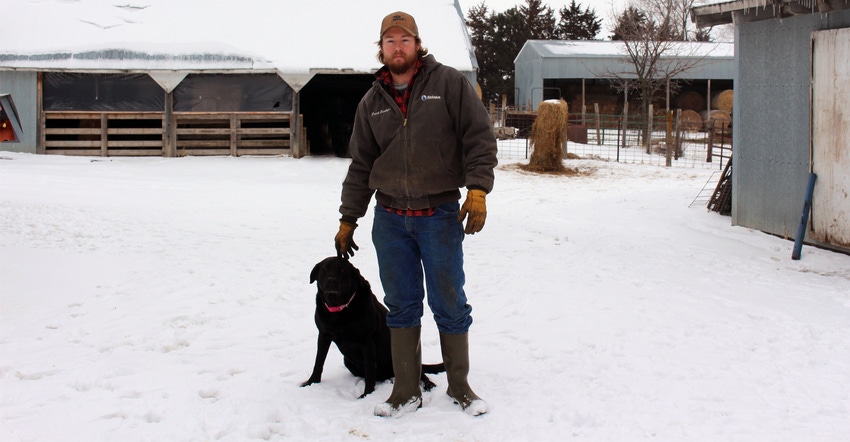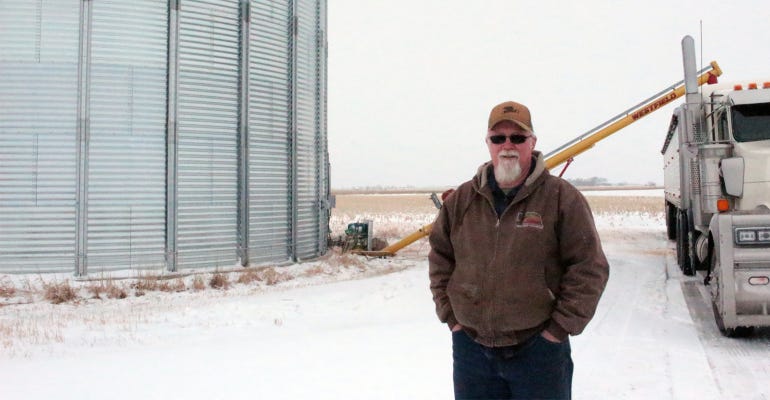February 26, 2020

By Chrystal Houston
It's a frigid winter morning near Beaver Crossing, Neb., where third-generation farmer Alex Daake farms with his father, Dave. Fresh snow has fallen during the night, covering the few inches already on the ground.
The temperature is in the 20s, but the wind is whipping so fast across the prairie that it feels much colder. The sky is overcast and sullen. The only movement is the snow skittering in sheets across the road and the herd of black Angus cattle grazing the winter stubble in a nearby field.
Alex Daake is one of the landowners in the Upper Big Blue Natural Resources District who is taking advantage of the Corners for Wildlife Program, which provides landowners the opportunity to help establish wildlife habitat on center pivot corners not capable of sustaining high yields.
Through the program, landowners receive an annual payment for the converted cropland, and animal populations are given a new home.
Wildlife habitat loss is a concern in Nebraska, where 97% of land is privately owned, and 93% of land is used for production agriculture. There are few wild areas remaining where animals have the necessary habitat to thrive.
Addressing that problem is the motivation for the Corners for Wildlife program, which is offered through a partnership with Pheasants Forever, the Nebraska Game and Parks Commission, the Nebraska Environmental Trust, and the Upper Big Blue NRD.
The Corners for Wildlife program was introduced in Nebraska in 1995. There are 13,463 acres across the state participating in the program. In the Upper Big Blue NRD, there are 48 Corners for Wildlife areas representing 226 acres.
Mary Patten, habitat partnerships specialist with Pheasants Forever, says that 70% of these properties remain in grass cover after the contract expires.
"We search to identify landowners that are passionate about wildlife and not just interested in a payment," Patten says. "Our hope is that the project stays as habitat at the conclusion of the five-year contract."
Habitat on marginal ground
"It's hard to take good, productive ground and not make money on it. But marginal corners and lowlands, rather than lose money on trying to farm those few acres every year, you might as well just plant some grass there and give it back to nature," says Alex, noting that the Corners for Wildlife area on his property is sloped and was always challenging to farm anyway.
Alex's father and farming partner, Dave Daake, established the property in the Corners for Wildlife program 20 years ago. Since then, it's become a haven for game birds, as well as other animals.
The Corners for Wildlife property is covered in tall grasses, bent with snow, and surrounded by a shelterbelt of cedars. Although the wind is blowing, the air is still inside the area protected by the line of trees.
Pheasants are surprisingly hearty and can survive the extreme temperatures of the prairie winter, as long as they have a high-quality habitat such as this one and sufficient waste grain in fields to dine on through the cold weather months.
Alex and others hunt pheasants and quail on this property. Alex notes the humans aren't the only predators — he's spotted a pack of coyotes in the area.

CONSERVATION-MINDED: Dave Daake fills a semi with corn on his property near Beaver Crossing, Neb. Daake established the property in the Corners for Wildlife program 20 years ago, and also owns 46 acres of wetland under a conservation easement with Ducks Unlimited.

Back in Alex's workshop, a large heater blasts a channel of warmth, keeping the workspace tolerable, if not quite toasty. Alex is meeting with NRD forestry manager Ken Feather to discuss a new windbreak project that eventually will protect his cattle on days like today.
While he recognizes he won't see the full benefit of the additional trees for a few years, it's a long-term investment he is keen to make.
"You see a lot of windbreaks that are getting torn out," Alex says, shaking his head. "Planting trees is good. If you tear out a windbreak, you should put one back in."
The trees will be helpful for his cattle and will provide additional habitat for wildlife. The NRD Conservation Tree Program offers low-cost trees in bulk, plus planting services, to make it easy and affordable to add, restore or extend windbreaks in the district.
Other conservation ventures
Corners for Wildlife isn't the only conservation project on the Daake family's property. Just down the road is Dave Daake, seemingly impervious to the cold as he fills a semi with corn.
He's farmed here since 1979, and finding ways to make the property profitable and environmentally sustainable has long been his goal. In addition to his active cropland, Dave owns 46 acres of wetland under a conservation easement with Ducks Unlimited.
"It's a hard place to farm, so this is the best use for the land," he says. "A lot of duck hunters use it every year."
Dave has been no-tilling on this land for 20 to 25 years.
"I started out slow and eventually fell in love with it," Dave says. "When you don't have to disk, it sure cuts your time down."
For the past 15 years, the Daakes have been exclusively no-till, a practice that benefits nesting birds, as it provides improved habitat in the fields.
"I can't see why anyone wouldn't no-till. … We're having above-average yield compared to the people around us," Dave says. "I would never go back to tilling."
Now father and son are turning their attention to another conservation practice — cover cropping. Cover crops usually are planted to prevent erosion and increase soil health, as well as nutrient availability for cash crops, but they also can provide valuable habitat and food for various wildlife.
Dave has used turnips as a cover crop with his seed corn for 10 years and is now introducing rye as well. "Start slow and make sure you can keep up with it" is his philosophy when it comes to new farming practices.
Alex is excited about cover crops, too. "My goal is to put cover crops on all of my acres," he says. "Studies show there's a real benefit to it."
And what benefits the farm's bottom line as well as the land is a no-brainer for the Daakes.
For more information on the Corners for Wildlife Program or the Conservation Tree Program, visit upperbigblue.org.
Houston is public relations manager for the Upper Big Blue Natural Resources District.
Source: Upper Big Blue NRD, which is solely responsible for the information provided and is wholly owned by the source. Informa Business Media and all its subsidiaries are not responsible for any of the content contained in this information asset.
You May Also Like




